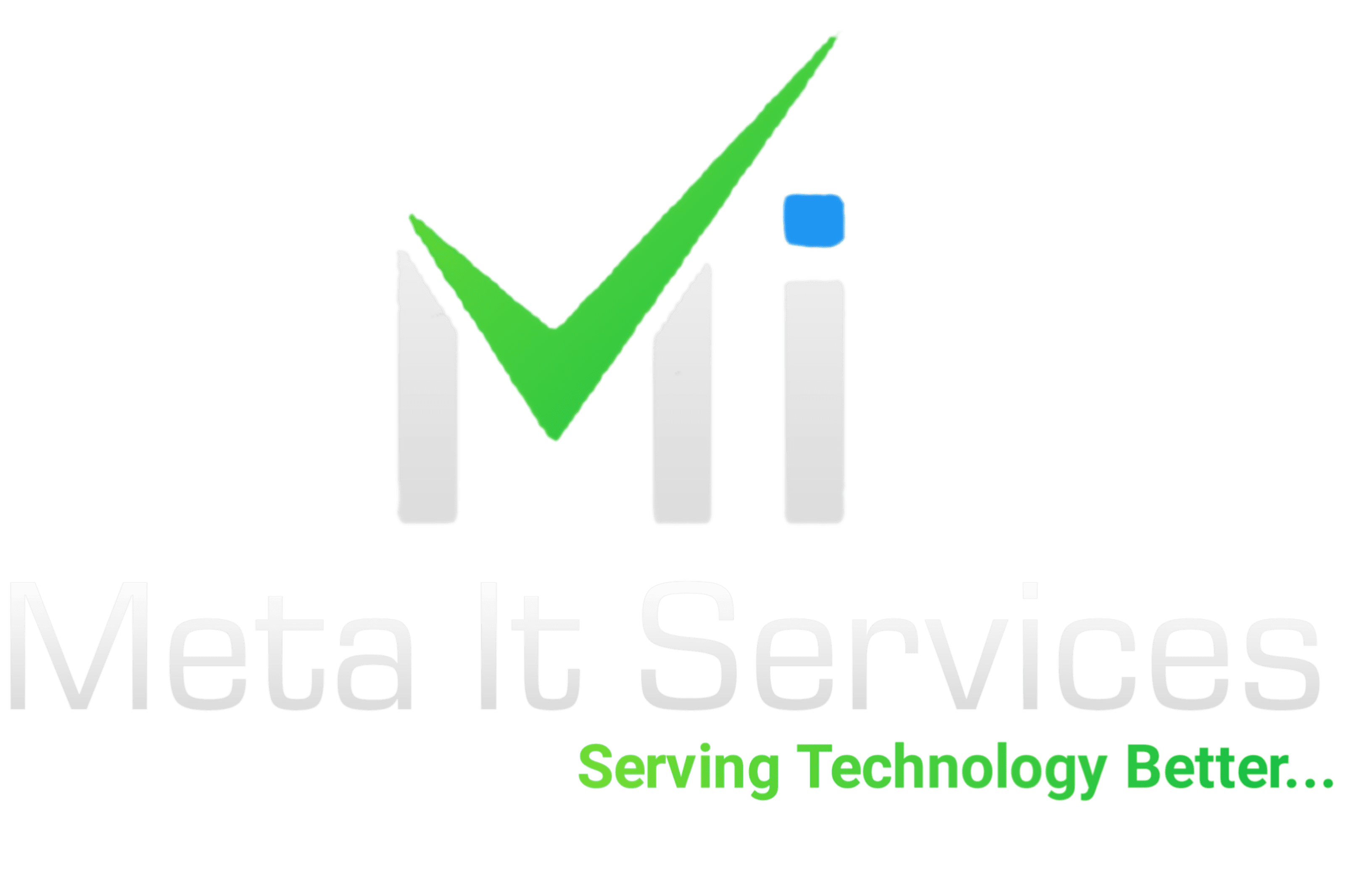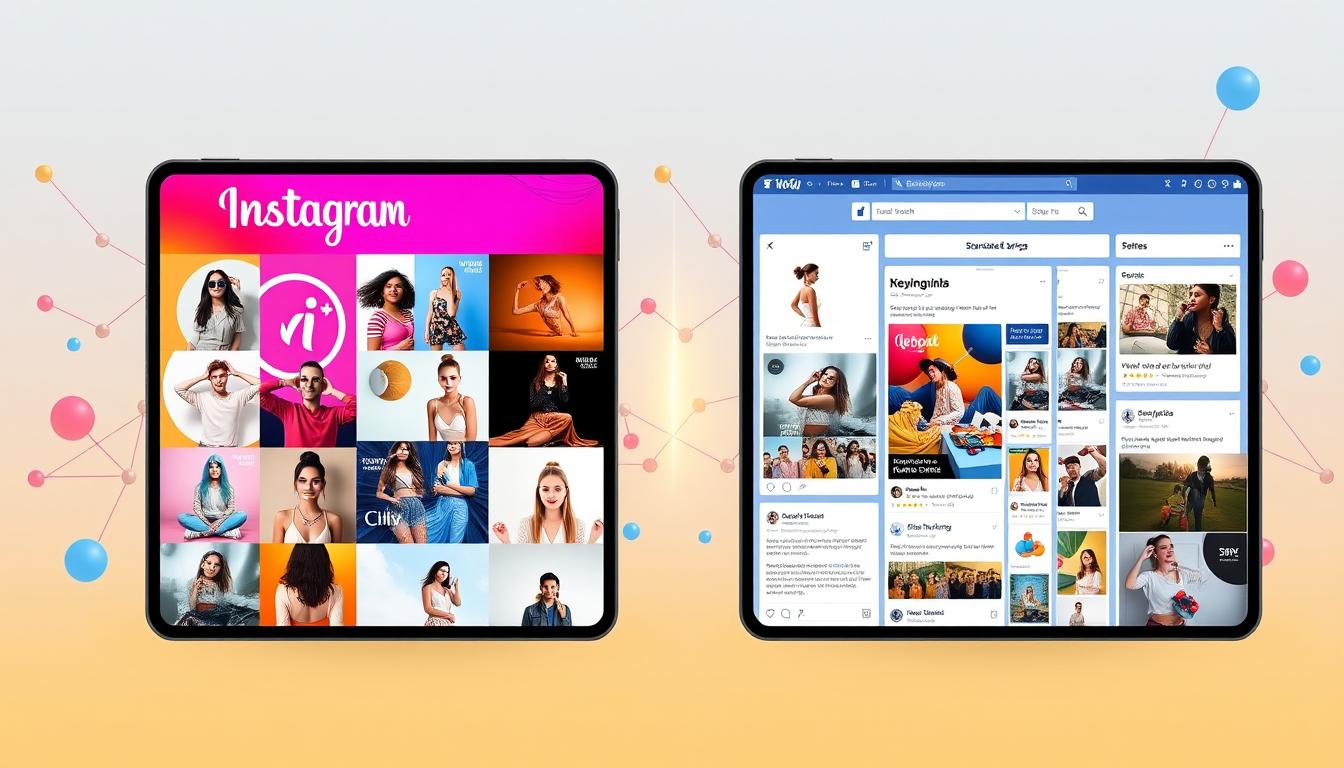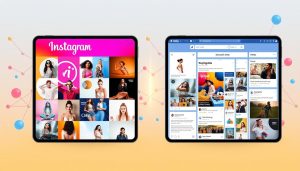Social media ads are key in today’s digital world. When we look at Instagram vs Facebook, we see two big players. Together, they have almost 2 billion daily active users.
Facebook reaches more people, while Instagram draws in the younger crowd. It’s important for brands to know their goals and who they want to reach. This helps them choose the right platform for success.
Facebook offers detailed targeting, while Instagram focuses on visuals. Our choice depends on what each platform does best. This way, we can make our ads work better.
Key Takeaways
- Facebook has a broader demographic reach compared to Instagram.
- Instagram tends to attract a younger user base.
- Brands may find better engagement through visually appealing content on Instagram.
- Facebook offers more ad objectives and detailed targeting options.
- Utilizing analytics is crucial for measuring success across both platforms.
- Clear campaign goals enhance the effectiveness of advertising strategies.
Welcome to Meta IT Services
Instagram vs Facebook Advertising !
Introduction to Social Media Advertising
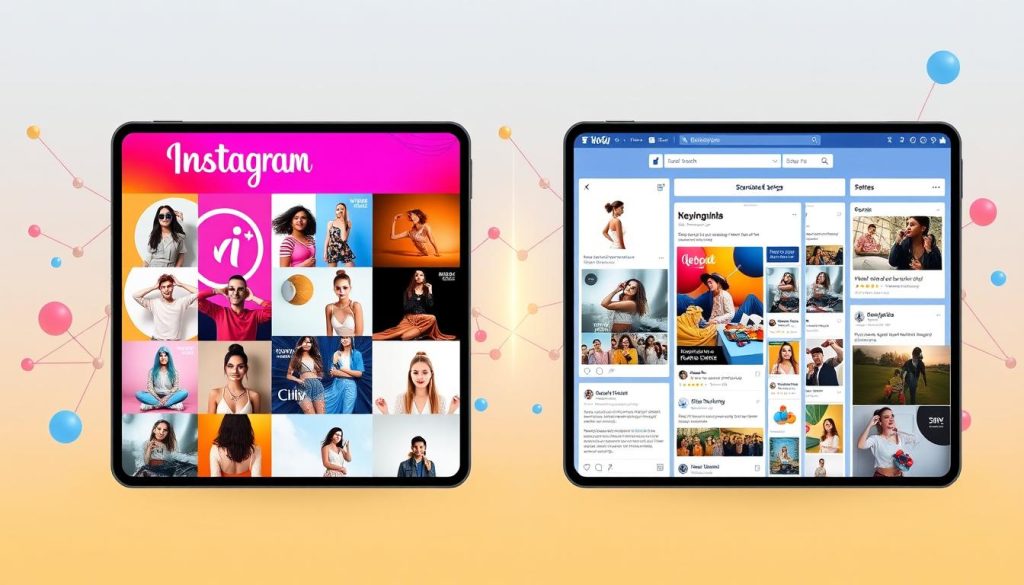
Social media ads are key in today’s marketing world. Brands use these platforms to connect with customers in a more personal way. As people spend more time online, they look to social media for info and to buy things.
Facebook and Instagram offer paid ads that cater to different audience needs. Facebook has 2.96 billion active users, making it a great place for businesses to reach people. Instagram, with 2.4 billion users, is perfect for brands that focus on visuals and working with influencers.
In 2023, companies plan to spend twice as much on social media ads. It’s important to use each platform’s strengths to engage with audiences. The right platform can make or break a campaign, shaping our marketing strategies.
The Popularity of Facebook and Instagram
Understanding Facebook and Instagram is key for any marketing plan today. Both offer unique ways to engage with audiences. But, their user bases are different, affecting how marketers choose to advertise.
Daily Active Users on Each Platform
Facebook has about 2.96 billion monthly users, leading Instagram with 2 billion. Facebook appeals to a wide range of people, while Instagram is more popular with the young. For example, 67% of 18-29-year-olds use Instagram, while Facebook is more popular among 25-44-year-olds, especially men.
Instagram users spend about 11.7 hours a month on the platform, compared to Facebook’s 19.7 hours. Instagram also has a higher engagement rate at 0.54%, showing a more active audience.
Marketer Preferences and Trends
About 80% of marketers choose Facebook for ads, but Instagram’s growth is notable. Brands see Instagram’s value for engaging with a younger audience who loves visuals. Instagram users are active, with 80% following a business and 60% looking for new products.
As trends change, it’s vital to adjust ads for both platforms. This ensures the best reach and results.
Understanding Facebook Ads
Facebook ads are a powerful tool for brands to reach more people and engage with users. They help promote products or services with messages in user feeds. This way, businesses can connect with their audience in a meaningful way.
What Are Facebook Ads?
Facebook ads are messages for brands to reach users in different places on the platform. They can show up in the News Feed, right column, Marketplace, and video feeds. This makes Facebook ads useful for businesses of all sizes to grow their brand and make sales.
Placement and Targeting Options
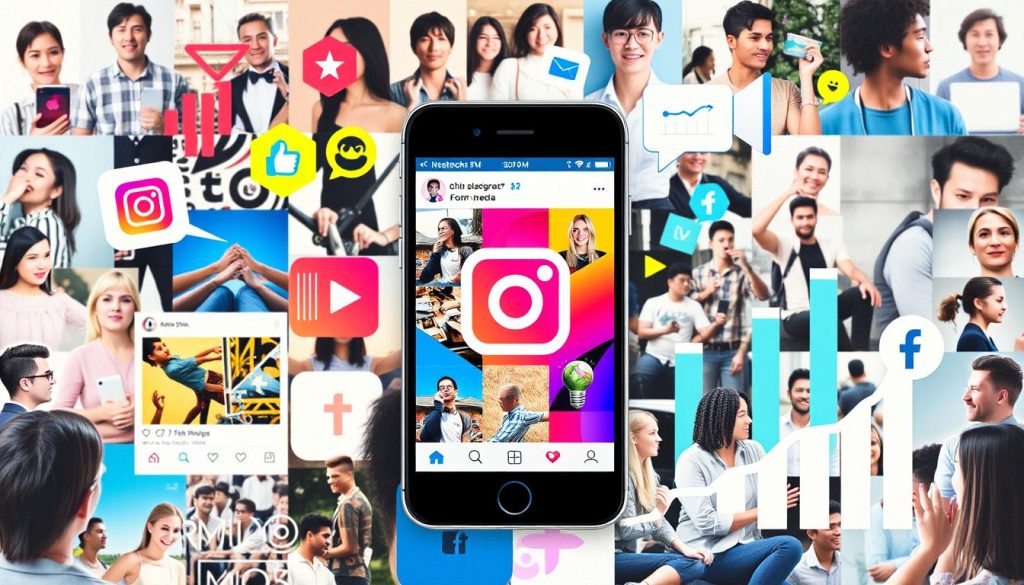
Facebook offers many ad placement options for marketers. Advertisers can target their audience based on demographics, interests, and behaviors. Features like Custom Audiences and Lookalike Audiences help find the right audience for ads.
This detailed targeting increases the chance of people engaging with ads. It also boosts the chances of making sales.
| Ad Type | Placement Options | Cost (CPC) | Cost (CPM) | Average CTR |
|---|---|---|---|---|
| Single Image Ads | News Feed, Right Column | $0.44 | $14.40 | 3.06% |
| Video Ads | News Feed, Marketplace | $0.44 | $14.40 | 3.06% |
| Carousel Ads | News Feed, Stories | $0.44 | $14.40 | 3.06% |
| Collection Ads | News Feed, Marketplace | $0.44 | $14.40 | 3.06% |
Understanding Instagram Ads
Instagram ads are a key part of digital marketing. They use visual stories to grab attention. These ads help brands connect with a wide range of people. They appear in feeds, Stories, and the Explore tab, boosting brand awareness.
What Are Instagram Ads?
Instagram ads are special posts that grab attention with visuals and interactive features. Businesses use them to show off their products or services in a compelling way. A study found that 50% of people become more interested in a company after seeing its Instagram ad.
Placement and Targeting Options on Instagram
Instagram ads fit well with the app’s look. They come in formats like video, carousel, and story ads. This makes the ads more engaging and helps spread brand messages.
There are many ways to target ads on Instagram. You can choose based on demographics, interests, behavior, location, and more. This helps brands reach the right people with their content.
- Demographics
- Interests
- Behavior
- Location
- Lookalike audiences
With these options, brands can make sure their ads hit the mark. For example, you can start advertising on Instagram with just $5 a day through Mailchimp.
Instagram ads cost between $0.20 and $2.00 per click. The cost for 1,000 impressions is about $6.70 on average. This makes Instagram ads a cost-effective choice compared to other platforms.
The platform uses a bidding system to set ad prices. This system considers ad relevance, click potential, and competition. This ensures ads are priced fairly based on their quality and appeal.
Instagram also offers detailed analytics to track ad performance. You can see metrics like impressions, clicks, and cost per click. This helps brands refine their strategies and improve their ads.
| Ad Format | Description | Engagement Type |
|---|---|---|
| Feed Ads | Static images or videos appearing in user feeds. | High engagement with the ability to like, comment, and share. |
| Story Ads | Full-screen ads that appear between user stories. | Encourages quick interactions, swipe-ups for links. |
| Carousel Ads | Multiple images or videos users can swipe through. | Improves storytelling potential and user engagement. |
| Explore Ads | Ads shown in the Explore area based on user interests. | Engages users interested in specific topics by aligning with their preferences. |
Using Instagram ads effectively can greatly boost a brand’s visibility. It also helps in creating engaging interactions in today’s fast-paced digital world.
Instagram vs Facebook Advertising
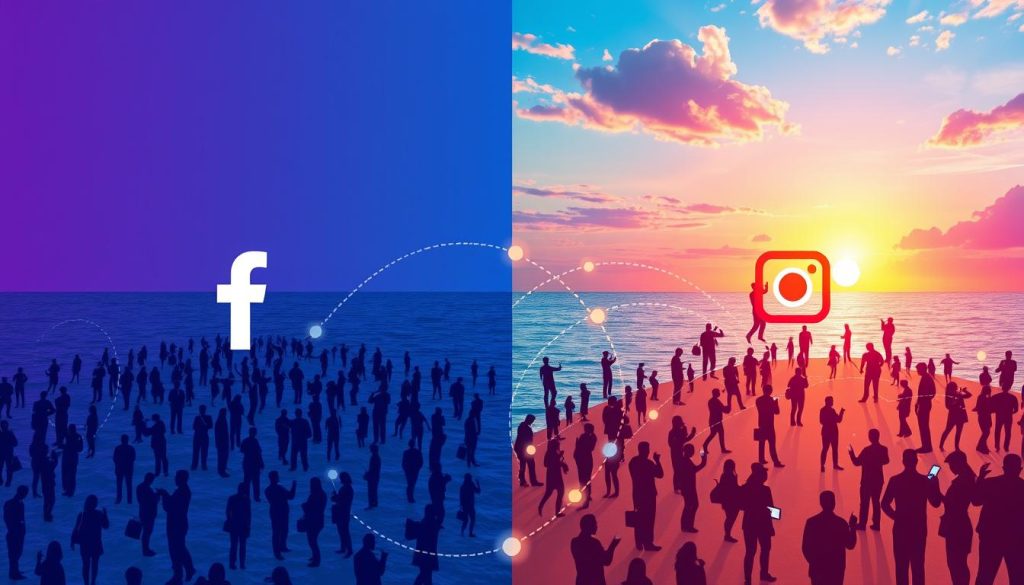
When we look at Instagram vs Facebook advertising, we see important factors that affect how well ads work. Both platforms have almost 2 billion people using them every day. This huge number of users is great for businesses looking to grow their marketing.
About 80% of marketers use Facebook ads. This shows Facebook’s strong place in the market. Instagram is growing and is expected to attract more advertisers as it gets better. Around 33% of Instagram users have bought something from an ad, showing its strong sales potential.
Cost is another key factor. Facebook ads cost about $0.50 per click, while Instagram ads cost around $1.10. This difference affects how much businesses spend and what they get back. Also, Facebook ads have a 3.06% click-through rate, much higher than Instagram’s 0.68%.
There are also differences in what types of content can be used. Facebook allows for longer videos and more varied content. Instagram, however, limits video ads to 60 or 15 seconds, requiring a more focused approach. Yet, campaigns on both platforms can show similar or better results, like more website clicks and conversions. Brands like MVMT Watches have even cut their costs per conversion by using Instagram with Facebook.
In conclusion, understanding the differences between Instagram and Facebook ads is crucial. By looking at how people engage with ads, the cost, and the types of content, businesses can make their ads more effective on both platforms.
Ease of Use Comparison
When it comes to advertising on social media, Facebook and Instagram have different ways of making it easy. We’ll look at how easy it is for beginners to start and the key features of their ad tools.
Learning Curves for Beginners
Instagram is great for new advertisers with its easy-to-use interface. Starting a campaign is simple, making it easy for newbies to get going. Facebook, on the other hand, is more complex. It has advanced features for seasoned marketers but might be tough for beginners to learn.
Ad Manager Features
Facebook Ads Manager and Instagram Ads Manager have similar features, making it easy to manage ads on both platforms. They both help track analytics, making it simpler to see how ads are doing. Instagram focuses on quick and simple ad creation, while Facebook offers more options for targeting and ad types.
| Feature | Facebook Ads Manager | Instagram Ads Manager |
|---|---|---|
| Ease of Use | Complex, requires learning | Beginner-friendly, straightforward |
| Ad Creation | Comprehensive options available | Simple and quick setup |
| Analytics Tracking | In-depth performance analysis | Basic performance metrics |
| Ad Formats | Diverse formats available | Limited to selected formats |
| User Interface | Advanced, robust features | Visual, less cluttered |
Ad Cost Analysis
Exploring ad costs on Facebook and Instagram is key to a good ad strategy. We see big differences in what it costs to run ads on these sites. Knowing these costs helps us plan our ad budgets better.
Cost Per Click (CPC) Differences
Facebook and Instagram have different costs per click (CPC). This affects how we spend our ad budget. Facebook’s CPC is about $0.44, making it a cost-effective choice for ads. Instagram’s CPC ranges from $0.40 to $2.00, with an average of $1.10.
This info helps us choose the right platform for our ads based on their strengths.
Factors Influencing Cost on Each Platform
Many things affect ad costs on Facebook and Instagram. These include:
- Competition: How many others are vying for attention affects our costs.
- Ad Quality: The quality and creativity of our ads impact their cost.
- Targeting Precision: Targeting our audience well can lower costs.
- Campaign Objectives: Our goals can change both CPC and CPM, requiring budget adjustments.
Understanding these factors helps us manage our budgets better. It also helps us get the most from our ad spending.
Ad Formats Available
Choosing the right ad format is key in social media advertising. Facebook and Instagram offer many ad formats. This lets brands create content that speaks to their audience.
Comparing Video & Image Ads
Video ads grab attention fast and share complex messages well. They work best in 15-30 seconds. Image ads, however, are simple and clear. They’re the most used on both platforms.
Carousel and Collection Ads Overview
Carousel ads tell stories with multiple images or videos. They let users swipe through at their own speed. Collection ads mix a main image or video with product images below. They make shopping on mobile better.
Audience Demographics and Engagement
Knowing who uses Facebook and Instagram is key to good ads. Each platform has its own crowd, shaping how we talk to them. Facebook has a wide range of users, with about 2.9 billion monthly active users as of Q3 2023. It’s popular with people aged 25 to 55.
Instagram, on the other hand, is for the younger crowd. Most users are between 18 and 34 years old.
Younger vs. Older Audiences
Brands targeting young people do well on Instagram. It’s where 78% of 18 to 29-year-olds hang out. Facebook, however, is a hit with 87% of millennials.
Knowing who’s on each platform helps us make ads that really speak to them.
Engagement Rates on Each Platform
Instagram wins when it comes to keeping users hooked. People spend about 151 minutes a day on social media. This means lots of chances to interact.
Facebook may reach more people, but Instagram posts get more engagement. Knowing this helps us make better ads on both platforms.
Performance Metrics and Analytics
We know how vital performance analytics are in social media ads. To measure success, we track important metrics like impressions, clicks, and conversions. This helps us keep our ads sharp and focused.
Tracking Success through Ad Performance
Understanding ad performance is key. In December 2024, Facebook Ads had a median Cost Per Lead of $41.26. This comes from over 7,000 digital marketing agencies. It shows how competitive ads on Facebook can be.
The cost per action also varies by industry. For example, it’s $7.85 in education and up to $55 in technology. Knowing these differences helps us improve our strategies.
Conversion Rates and ROI Analysis
Conversion rates help us see how well each platform works. In December 2024, the median monthly spend for Facebook Ads was $784.33. This shows the investment needed for good ad reach.
Brands in apparel and fashion spent even more, at $1,919.92 per month. Looking at the Return on Ad Spend (ROAS) is also key. It helps us see if our campaigns are profitable and guides future budgeting.
| Platform | Median Cost Per Lead (Dec 2024) | Median Monthly Spend (Dec 2024) | Cost Per Action Range (Industry) |
|---|---|---|---|
| Facebook Ads | $41.26 | $784.33 | $7.85 – $55 |
| Apparel & Fashion | N/A | $1,919.92 | N/A |
Content Strategy for Advertising
In digital marketing, a good content strategy is key for better ad performance on social media. Each platform, like Instagram or Facebook, needs its own plan to connect with users. Instagram focuses on visuals, while Facebook is all about detailed information.
Visual Content for Instagram vs. Informational Content for Facebook
Instagram is all about eye-catching images that grab the attention of younger people. It’s a great place for brands to show off their products in a beautiful way. This approach helps build a strong connection with users.
On the other hand, Facebook is for a wider range of people, especially those 25 to 55+. They like posts that are informative and detailed. It’s important to match our content with what our audience likes.
Aligning Content with Audience Preferences
Knowing what our audience likes helps us create better content. By matching our messages with what users enjoy, we make their experience better. This leads to more people interacting with our content.
Instagram users love posts that are visually appealing. Facebook users, however, prefer content that tells a story or gives them useful information. By tailoring our content, we can get more people to click and buy.
| Platform | Content Type | Target Audience | Engagement Style |
|---|---|---|---|
| Visual | Aged 18-34 | High emotional connection, visual appeal | |
| Informational | Aged 25-55+ | Detail-oriented, community-focused |
Testing Strategies for Ad Effectiveness
A/B testing is key to checking how well our ads work on Instagram and Facebook. It helps us see which ads our audience likes best. This way, we can make our ads better over time.
By testing different ads, we learn what grabs our audience’s attention. This knowledge boosts how much people engage with our ads.
A/B Testing Across Platforms
Testing ads on both Instagram and Facebook gives us important data. For example, Instagram ads cost more, with a CPC of $1.33. Facebook ads are cheaper, at $0.76.
Instagram ads get more clicks, with a CTR of 1.44%. Facebook ads have a CTR of 0.90%. This shows Instagram ads are more engaging, but also more expensive.
Iterative Improvements Based on Analytics
Keeping an eye on our analytics helps us get better over time. For instance, Facebook ads reach more people and get more clicks. They outdo Instagram in reach and clicks by a lot.
This means we can tweak our ad strategies to get better results. It’s all about making smart changes based on what we learn.
| Platform | CPC | Reach | Clicks | CTR |
|---|---|---|---|---|
| $1.33 | 27,347 | 393 | 1.44% | |
| $0.76 | 76,971 | 689 | 0.90% |
By understanding these differences and adjusting our ads, we can make them more effective. This way, we get more value from our ad spending.
Conclusion
Choosing between Instagram and Facebook for social media ads is a big decision. It depends on our brand goals, who we want to reach, and how we plan to share our content. Instagram is great for reaching young people with its 1 billion monthly users. They love visual content.
Facebook, on the other hand, has 2.8 billion users. It’s good for reaching more people and has tools for targeting specific groups. This helps us connect with different kinds of people.
Looking at how well our ads do, we see Instagram’s strong engagement. But Facebook might be cheaper and better for getting people to visit our website. The best choice depends on the data from both platforms.
Trying out different ads on Instagram and Facebook helps us get better results. We can use each platform’s special features to make ads that really speak to our audience. This way, we can meet our marketing goals and get a good return on our investment.
FAQ
What are the main differences between Instagram and Facebook advertising?
Facebook has a wide range of users across different ages. Instagram, on the other hand, focuses on younger people with visual content. Instagram ads also cost more per click than Facebook ads.
How do I determine which platform is better for my brand?
First, think about your marketing goals and who you want to reach. Facebook is good for a wide audience. Instagram is best for brands that love visuals and want to connect with the young crowd.
What are the costs associated with running ads on Facebook and Instagram?
Facebook ads cost about $0.50 per click, while Instagram ads are over $1.10. But, costs change based on how competitive the ads are, their quality, and who you’re targeting. Knowing these factors helps us budget better.
What ad formats are available on Facebook and Instagram?
Both platforms offer ads like images, videos, and more. Facebook has a wider range of ad types. Instagram focuses on ads that are visually appealing and tell stories.
How can I measure the effectiveness of my advertising campaigns?
We can track success with metrics like impressions, clicks, and conversions. By looking at how our ads perform, we can make them better.
Is there a learning curve for beginners using Facebook and Instagram ads?
Yes, Instagram is easier for newbies to use. Facebook’s ads have more advanced features that take time to learn.
What role does audience engagement play in each platform’s advertising success?
Engaging with the audience is key. Knowing what each platform’s users like helps us make our ads more effective.
How can I improve the return on investment (ROI) for my ads?
To boost ROI, target your ads better, refine your content, and keep an eye on your analytics. Testing different versions of your ads and making changes based on results can help a lot.
